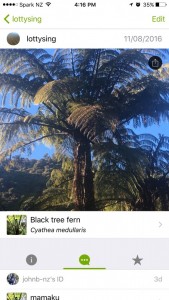Solutions focus: How iNaturalist could make a difference for the planet and replace Pokemon Go this Conservation Week
 I’m standing on a dirt road pointing my phone at a cheeky little creature as I try to catch it on my iPhone screen. The toddler on my back and the dog at my side wait patiently as I call out to it and try to get closer. But it flits about, and finally darts out of range. We plod on, looking for more beings to capture on screen.
I’m standing on a dirt road pointing my phone at a cheeky little creature as I try to catch it on my iPhone screen. The toddler on my back and the dog at my side wait patiently as I call out to it and try to get closer. But it flits about, and finally darts out of range. We plod on, looking for more beings to capture on screen.
Today I’ve downloaded two apps onto my phone. One is Pokemon Go, the newly released app which had been downloaded 75 million times by the end of July. The other is iNaturalist, also a free app that has been downloaded 140,000 times to date. I’ve just taken them both for a spin, nearly recording a photo of a Piwakawaka, a very friendly fantail, up Bird’s Clearing, on the iNaturalist app. There were no Pokemon to be found.
From September 10 to 18th everyone in Golden Bay is invited to join ‘Project GB Bio Go’ using the iNaturalist app. They will be challenged to identify three native animals, three pest animals, three native plants and three pest plants. While some, such as matai, passionfruit vine and weta will be easy to find, others won’t be. Mistletoe, geckos and fallow dear fall into the ‘difficult’ category. I’m told fallow dear hang out in the east side of the Takaka Valley, they come out in the paddocks (who knew?).
‘Project GB Bio Go’ is lead by Department of Conservation community ranger Greg Napp and Tasman District Council education and partnership officer Claire Webster.
Greg sees the project as a transparent way for public to record what they’re seeing, online, so that experts can make use of the data. He calls it “Citizen Science,” a term used around the world.
“It would be awesome to have a lot of people out there using the app. We have few rangers so we need everyone’s eyes and ears, everyone out looking, taking photos and referencing them with GPS. We don’t know how far some of our pest species have spread, we don’t know enough about where our rare species are so all sightings will be useful.”
How does the iNaturalist app work? Once you’ve downloaded it, you can search for project ‘GBBioGo’ and join up. iNaturalist is similar to Pokenmon Go in that you can observe the world through your camera, plus you’ll appear on screen thanks to google maps. You need to ‘catch’ your find in a photo and it’s about here that Pokemon and iNature kiss goodbye.
Once you’ve uploaded an image it will be locked into the google map so that others can also find it, for example the nearest observation to my house is a Pukeko, by ‘sea-kangeroo’ on Cassidy’s Corner; and near Three Oaks ‘glenn-nz’ has identified a masked lapwing bird.
One of the cool things about iNaturalist is that your image will be flagged to a New Zealand expert, who will officially identify it if you chose that option. It might even get a flash Latin name, for example Circus Approximans, which is a swamp harrier bird.
For groups there will be local support available. Claire and Greg will line up experts to help groups identify species. Also – for each species there will be an information sheet with details of preferred habitats, photos and other helpful data. Information sheets will be available at TDC, the Library, DoC and via the app.
Amongst those participating, Greg and Claire hope tech savvy young folk will buddy up with locals who have a good knowledge of our natural environs to learn off each other and have fun exploring.
The website Nature Watch NZ is where you can keep a track of findings.
Right, I’m off to look for a white-faced Heron (Egretta novaehollandiae) at the Rototai Reserve with my canine and toddler side kicks. Oh and we’ll keep an eye out for Pokemon.
Contacts:
Department of Conservation community ranger Greg Napp [email protected] and 03 525 8026
Tasman District Council education and partnership officer Claire Webster – [email protected] and 525 0020
Useful links:
Inaturalist.org
Naturewatch.org.nz
loading...
loading...
Tags: iNaturalist



Voices of our community